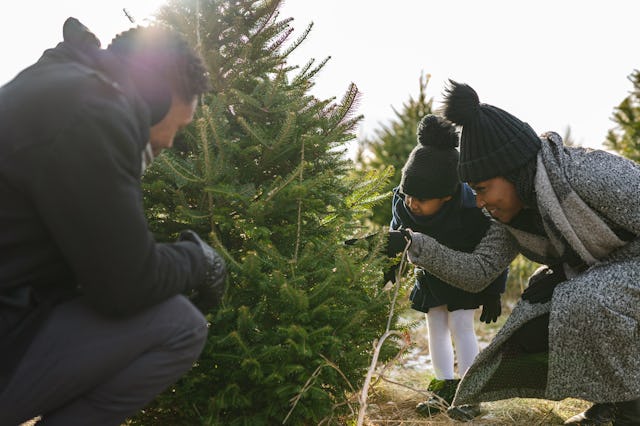How Long Does It Take To Grow A Christmas Tree? A Lot Longer Than You Think
You know your kid is gonna ask — might as well have the answer ready.

The holidays are finally here, which means your kids have shifted from their typical incessant questions to more seasonal ones. Gone is "Why is the sky blue?" only to be replaced with "How old is Santa Claus?" Or, if your holiday traditions include making a fir or spruce look festive, "How long does it take to grow a Christmas tree?" And even though you probably don't have plans to create a DIY pick-your-own situation, it's nice to have an answer fired up and ready for when your kid asks.
Before diving in and discovering how long it takes to grow a tree, let's talk a little bit about Christmas traditions. Traditions make the holiday season feel warm and cozy. What are your family favorites? If you don't have any traditions with your kids, now is the time to consider starting one. It can feel overwhelming to start another thing you have to keep up year after year (looking at you, Elf on the Shelf), but it doesn't need to be complicated.
Going on a drive to see the lights, a paper chain countdown, handmade salt dough ornaments for your tree, and decorating cards to pass out at your local nursing home — these ideas cost next to nothing and are rituals you and your kids can look forward to each December. And if you try something and it doesn't fit your family, it's totally fine to scratch it off the list and try something new.
Now, are you ready to learn more about the timeline of growing a Christmas tree? Keep reading.
How long does it take to grow a Christmas tree?
There's no simple answer here. Christmas trees vary widely in how long they take to grow. Many factors influence this window, including climate, soil conditions, the type of tree, and whether you're starting from seed or sapling. Christmas trees growing to maturity can take anywhere from four to 15 years, but according to The National Christmas Tree Association, the average is seven years.
It's important to note that if you want to plant your own Christmas trees, you'll need to research what varieties grow best in your region before beginning. Christmas trees also require a lot of maintenance and work, including frequent shearing, to end up with the classic Christmas tree shape we all know and love.
Basically, growing a Christmas tree takes a lot of TLC and patience. This may be a bigger project than most families want to take on. Remember when your kid promised that if you got them a guinea pig, they'd feed it and clean its enclosure daily? How's that working out for you? Keep that in mind when they swear they'll nurture a little sapling.
What are the benefits of growing or buying a real Christmas tree?
Whether you opt to grow your own Christmas tree or get one from a pick-your-own farm, choosing a real tree offers a few benefits over its artificial counterpart. To start, there are environmental benefits to choosing a real Christmas tree. Real Christmas trees provide oxygen for the surrounding community as they grow; they're easily recyclable; and many towns and cities offer a tree pickup service after Christmas each year.
Aside from the fact that it's good for the planet, this also means you don't have to find a place to store a big bulky artificial tree all year long. Another benefit to buying a real Christmas tree from a local farm is supporting a small, often family-run, business in your community. Not to mention the nostalgia factor — the smell of a real tree can't be faked, even with the yummiest scented candle.
Of course, growing or buying a real tree also has cons. If you have allergies, real trees could exacerbate your symptoms. And it can get pricey to buy a new tree every year, whereas artificial trees are a one-and-done deal — or at least don't need to be replaced as often. Real trees also bring the risk of a house fire if the needles start to dry out. Plus, they're messy. (Again, we know who'll get saddled with sweeping up fallen needles every day, right?)
Although the pro/con list above gives a brief overview of the benefits and downsides of choosing a real tree, only you really know the best choice for your family... and that choice might change with each passing year. But, for now, at least you have a solid response when your kid starts firing off questions about the time it takes to grow a Christmas tree.
Good luck with all the other (endless) queries.